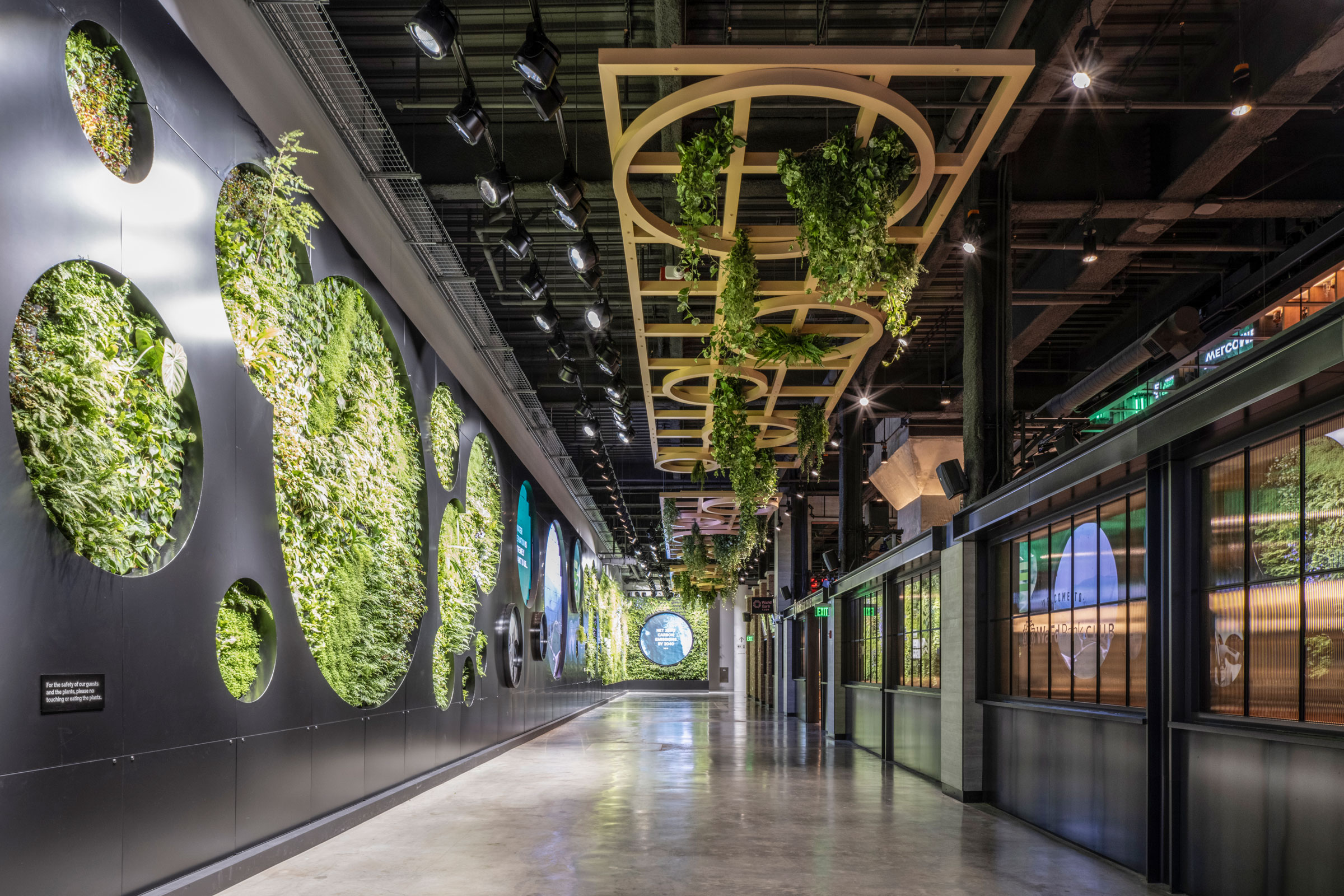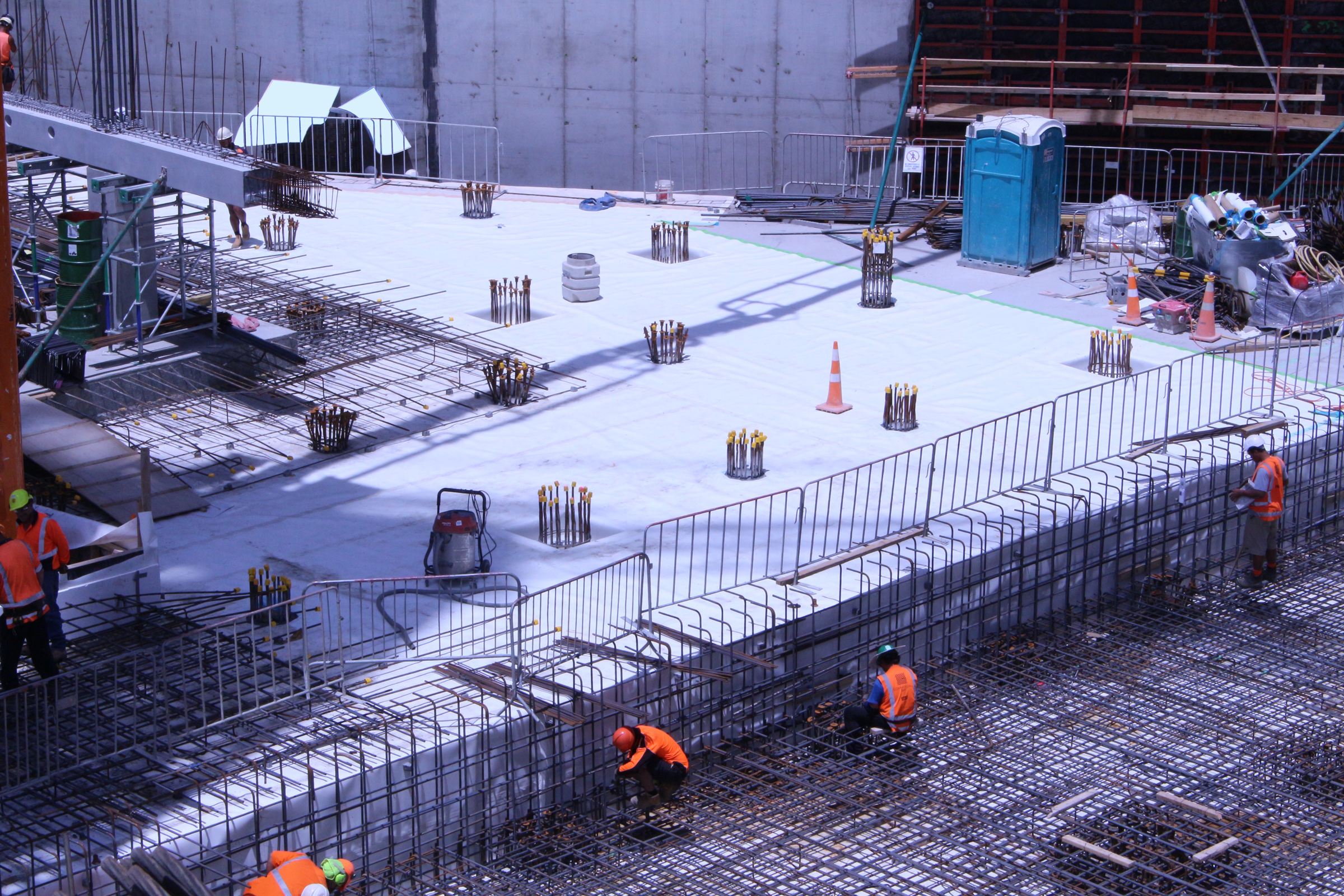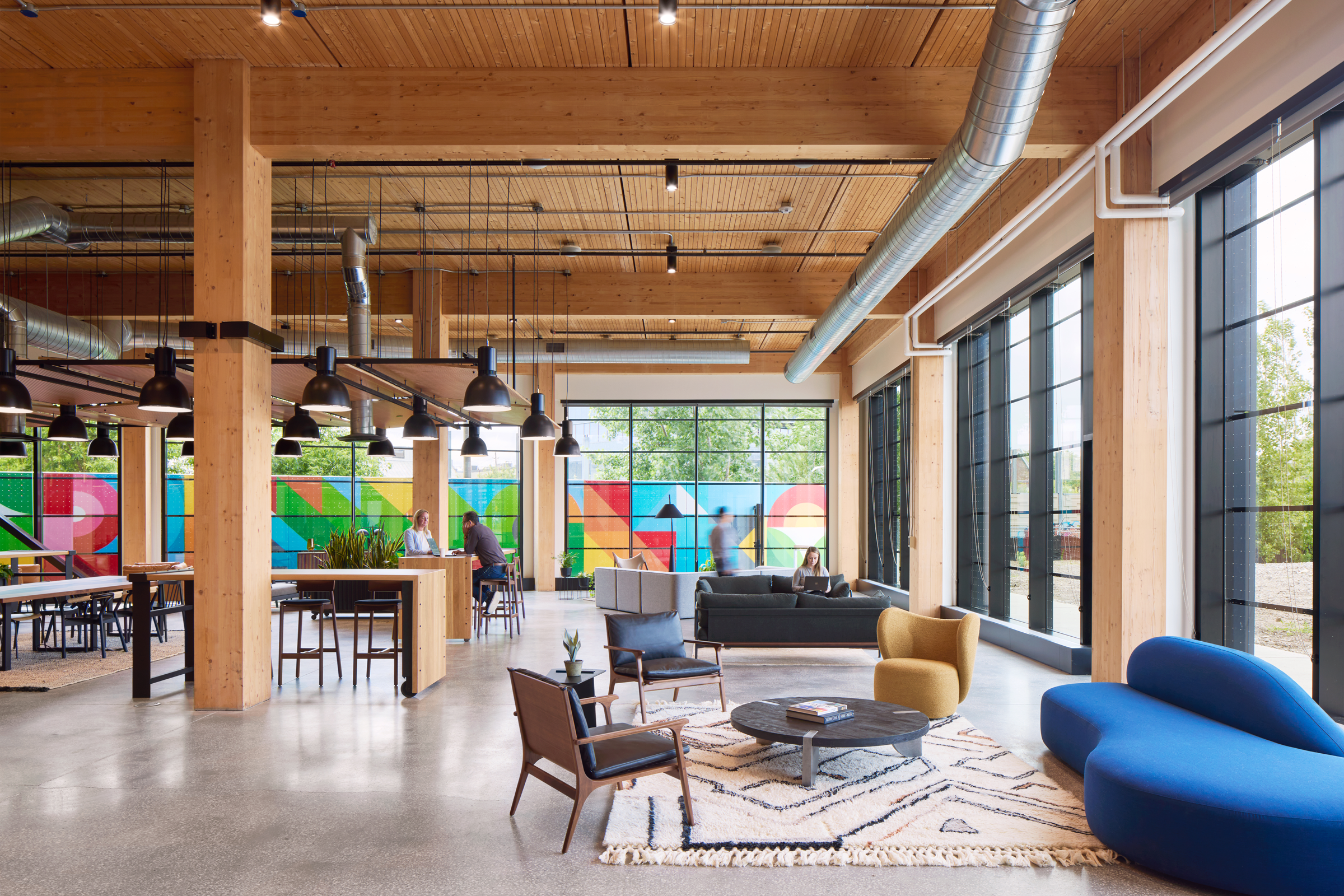Story at a glance:
- Visitors to the Climate Pledge Arena in Seattle are greeted by a 200-foot-long living wall.
- Nashville’s SoundWaves Waterpark plays host to 3,338 square feet of living walls and vertical gardens.
- The living wall in Geelen’s Counterflow Office is one of the largest in the Netherlands.
Incorporating greenery and indoor vegetation into the built environment has become a staple practice of the green and wellness movements, both of which value biophilia—or the belief that a connection to nature is key to a healthy, fulfilling life—as a core concept.
And while there are many ways to bring plants into a space, few are more impressive than living walls. “When you see a green wall you’re immediately drawn to it. It’s alive, it’s interesting, and it fulfills our biophilic needs,” Matt Hills, vertical garden and green wall expert at Ambius, previously wrote for gb&d.
In this article we explore the basics of living walls and shine a light on seven living wall examples from around the world.
What is a Living Wall?

Living walls intentionally incorporate live plants into their designs. Tray living wall systems—like the one pictured above—make it extremely easy to add and remove plants. Photo courtesy of Ambius
Living walls are vertical built structures that intentionally incorporate live vegetation and a vertically applied growth medium into their designs. Plants in living walls may be grown directly in soil, a substitute substrate, or via hydroponic methods. There are three basic living wall configurations: modular/panel, tray, and freestanding.
- Modular/panel. Plants are pre-grown in panels or tiles with integrated planting media and irrigation and are installed vertically on a framing support system.
- Tray. Consist of a backing board and rows of angled openings into which pots may be slotted into; these systems may be irrigated via direct plumbing or holding tanks.
- Freestanding. As the name suggests, freestanding living walls are not attached to a permanent wall, meaning they can be moved around.
Ambius—a leading provider of interior landscaping, living green walls, scenting solutions, and hygiene services—specializes in both panel and tray living wall systems.
Most living walls are installed indoors, though it is possible to install them along exterior walls as well—green facades, however, tend to be the favored choice for outdoor spaces.
Livings Walls vs Green Facades
Green facades are similar to living walls in that they contain live, actively growing plants, though they differ in terms of how those plants are actually supported by the wall system. Rather than incorporate a substrate or growing medium along the vertical face itself, green facades have the growth medium at their base and utilize trellises or other structures to support plants as they grow upwards.
Unlike living walls—which can support a wide variety of plant species—green facades typically only incorporate climbing and vining plants; green facades are also exclusively installed outdoors.
The Advantages & Disadvantages of Living Walls
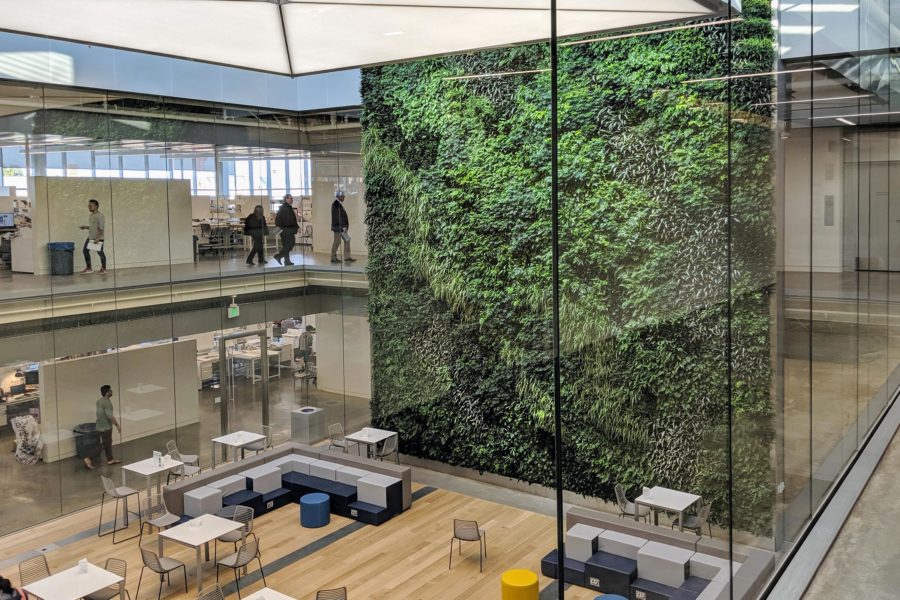
Biophilic designs, like large living walls, add beauty and wellness to offices, universities, restaurants, and more. Photo courtesy of Sagegreenlife
Now that we’ve established what a living wall is, let’s take a look at the advantages and disadvantages associated with these green features.
Advantages
Given their rise in popularity over the last decade or so, it should come as no surprise that living walls offer a host of benefits, including:
Invokes a Biophilic Response
Living walls are extremely striking visual features that, upon viewing, instantly forge an innate connection to the natural world, making them a powerful biophilic design tool. Science also suggests that viewing living walls and other biophilic features that incorporate vegetation has positive psychological and physiological impacts. “There’s lots of data [pertaining to indoor living walls] on the physical sense of well-being: lower cortisol, better attention, reduced turnover,” Darren Mende, COO of SageGreenLife—a leading provider of living wall systems—previously told gb&d.
Science also suggests that viewing living walls and other biophilic features that incorporate vegetation has positive psychological and physiological impacts. According to research conducted by experts at the Texas A&M Department of Horticultural Sciences, simply looking at plants helps to lower the body’s cortisol (the hormone that regulates stress) levels. Because they are capable of reducing stress, living walls have the potential to combat anxiety, depression, and other mood disorders, leading to improved mood and greater life satisfaction.
Visually Appealing
A well-maintained living wall makes for an incredibly interesting and visually appealing feature, helping to bring color and vibrancy to an indoor space. “By now most people understand the health benefits of adding living walls to projects, but what I’m seeing more is interest in large-scale green walls for their visual appeal,” writes Hills.
Improved Air Quality
While the air-cleaning capabilities of indoor plants are often grossly overstated, large living walls that contain upwards of a thousand plants can play a minor role in improving indoor air quality. This is due to plants’ natural ability to absorb carbon dioxide and produce oxygen during photosynthesis. Certain plants can also absorb trace amounts of specific volatile organic compounds, further contributing to their positive impact on indoor air quality.
Disadvantages
Despite these advantages, living walls are not without their drawbacks. Fortunately most of these disadvantages are easily mitigated or avoided when living walls are properly designed and installed.
Potential for Moisture Damage
As with any building feature or fixture that involves water, living walls have the potential to cause moisture damage if they are not properly installed and/or maintained. Damage or improper installation of the waterproof membrane/backing, for example, can cause moisture to infiltrate the wall assembly itself; if left unchecked, this can lead to mold, mildew, and even structural damage.
Hydroponic living walls and larger living walls with dedicated water delivery systems provide even more chances for moisture damage, as leaks may occur at any point in the irrigation plumbing, leading to potential mold or mildew growth.
May Introduce Pollutants
Despite having the capacity to moderately improve indoor air quality, living walls can also negatively impact indoor air quality as well. Over-watering plants can, for example, cause mold to grow on the substrate, potentially triggering allergies and asthma symptoms as spores are released into the air. Living walls also provide large, complex surfaces for dust to accumulate on; if left to gather, this dust can be distributed into the air by drafts and HVAC usage, triggering allergies and exacerbating existing respiratory conditions.
Require Maintenance
While all walls require maintenance to some degree, few are as maintenance-intensive as living green walls. Small living walls and living wall panels, for example, require regular hand-watering or misting; larger living walls typically don’t require hand-watering thanks to their dedicated water delivery systems, although irrigation systems themselves do require maintenance to ensure they are working properly.
Depending on the types of vegetation featured in the wall, maintenance duties may also include pruning and removal of dead plant matter to ensure proper growth and address pests or disease. As we’ve already mentioned, it is also extremely easy for living walls to gather dust, meaning routine dusting with a damp cloth is another necessary step for proper upkeep.
If maintenance isn’t kept up to date or the ideal growing conditions aren’t being met, a beautiful living wall can quickly become an eyesore.
7 Living Wall Examples to Inspire Sustainable Living
Here are seven living wall examples from projects around the world.
1. Climate Pledge Arena, Seattle

Climate Pledge Arena is home to a 200-foot living wall with greenery hanging overhead—an Amazon vision Populous brought to life. Photo by Ema Peter
In a building teeming with sustainable features, the Climate Pledge Arena’s 200-foot-long living wall might just be the most impressive. Designed by Habitat Horticulture, the living wall includes more than 8,500 plants across 32 species native to the Pacific Northwest and is one of the first things visitors see when entering through either the northwest or west concourse entrances.
Habitat Horticulture’s living wall systems are made possible thanks to their proprietary geotextile fabric, which provides a versatile foundation for plant growth and facilitates equal water distribution. “The living wall is sustained by a material that we’ve developed called Growtex. It’s a geotextile that’s made from recycled plastic water bottles,” David Brenner, founder of Habitat Horticulture, said previously.
“The water is distributed at the top of the living wall, and that Growtex material helps move the water evenly. At the base of the wall, it’s captured in a trough and that goes to a recirculating tank, then reusing that water and sending it back to the living wall.” The recirculating water system contributes to the arena’s overall sustainability by reducing water consumption by 35%.
2. SoundWaves Waterpark, Nashville

Ambius installed 3,338 square feet of living walls at the SoundWaves waterpark at Gaylord Opryland Resort & Convention Center in Nashville in fall 2018. Courtesy of Ambius
Designed by BLUR Workshop for the Gaylord Opryland Resort & Convention Center, the SoundWaves Waterpark is an inspiring example of how living walls can be incorporated in both a fun and functional manner.
The project features 3,338 square feet of living walls. Ambius installed SoundWave’s vertical gardens to not only be aesthetically pleasing, but also serve to conceal the less attractive aspects of the rides themselves.
“The team behind the new water park with indoor/outdoor waterslides wanted living walls to help break up the space, add privacy, and also act as works of art,” Hills wrote for gb&d. “We designed and built many double-sided green walls you can see from any direction.”
Most of the living walls use an angled tray-based system, allowing the plants to remain in their nursery pods and facilitating ease of removal in the event that individual plants need to be taken out and replaced; the tray system also helps deliver water to the vegetation.
3. Kempegowda International Airport, Bengaluru, India
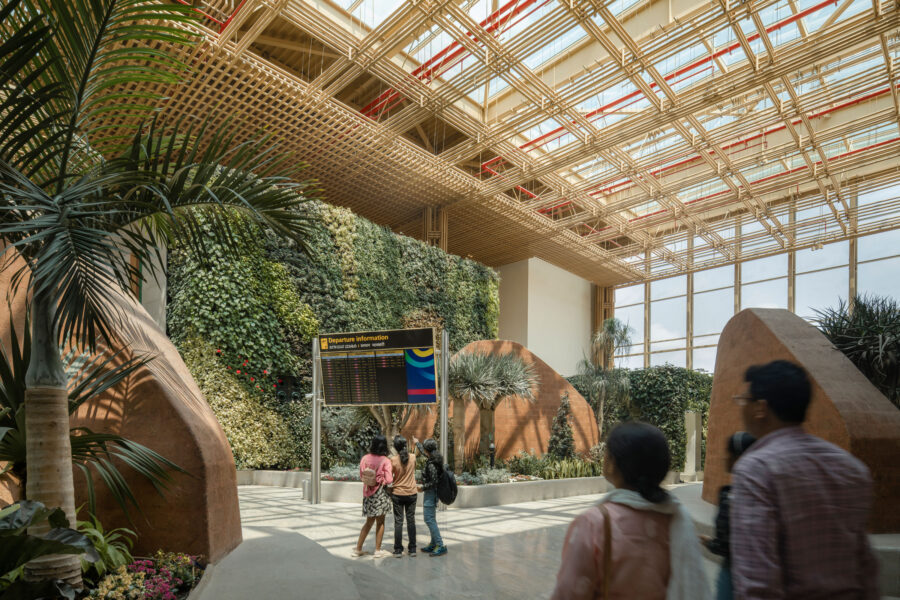
SOM designed the T2 project at Kempegowda International Airport in India to immerse passengers in hanging gardens, surrounded by plants and the soothing sounds of water. Photo by Ekansh Goel, Studio Recall
It’s not everyday that walking into an airport terminal feels like stepping into a jungle—but then again, Kempegowda International Airport Terminal 2 is no ordinary terminal. Designed by Skidmore, Owings & Merrill (SOM) in collaboration with landscape architecture firm Grant Associates, the terminal is home to lush internal gardens and hundreds of thousands of plants. “We wanted to radically reimagine the travel experience by connecting passengers to nature along each step of their journey,” Peter Lefkovits, design principal at SOM, previously wrote for gb&d. “From check-in to boarding, passengers experience a sequence of distinctive spaces, each integrated with a variety of sensory landscape features.”
Living walls play an integral role in the terminal’s design, with multiple vertical gardens found throughout the space; the green walls lining the corridor between the check-in counters and security gates alone contain approximately 450,000 live plants. A nearly 33-foot-tall green wall running the length and breadth of the terminal acts as the centerpiece, boasting over 450 different species of plants from all around the country.
In 2024 the terminal unveiled yet another living wall called Tiger Wings, designed in collaboration with noted French botanist Patrick Blanc. The 4,000-square-foot living wall incorporates more than 15,000 plants and 153 species, many of which are native to Karnataka and the forests of the Western Ghats. The plants are arranged to depict a tiger—India’s national animal—in front of airplane wings when in bloom.
As part of the terminal’s commitment to sustainability and resource conservation, the living walls are nourished by an automated rainwater-fed irrigation system whose water is harvested entirely on-site.
4. Arch | Nexus SAC, Sacramento
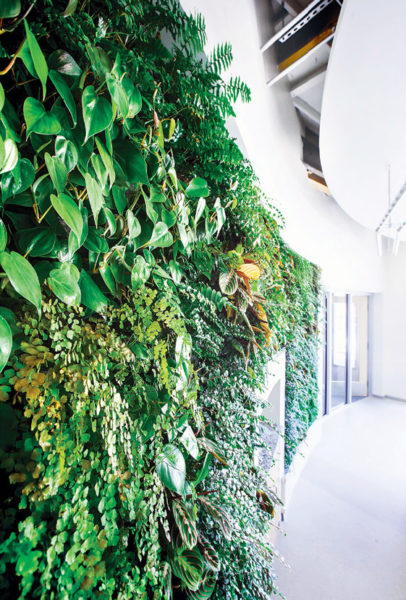
The curvilinear living wall in the Arch | Nexus SAC office can be seen from the street. Photo courtesy of Arch | Nexus
Alongside sustainability, multidisciplinary architecture and design firm Arch | Nexus considers inspiration to be one of its core values, one they strive to incorporate into all of their designs—including their own offices and studios. Greenery and vegetation often play an important role in this, as evidenced by the Arch | Nexus SAC studio in downtown Sacramento.
The office’s curvilinear living wall—which extends from the lobby into the work area and can be viewed through a window from the street—helps provide increased visual interest and has even brought curious pedestrians into the building to learn more. Also designed by Habitat Horticulture, the living wall contains a diverse mix of plants and brings an intense vibrancy to the neutral-toned workspace.
Because the building was designed to Living Building Challenge standards, the office is 100% water positive, relying solely on rainwater harvesting for water collection; gray water is treated by a Blue Future gravel and sand filtration system before being used to irrigate the green wall and flush toilets.
5. Geelen Counterflow Office, Haelen, Netherlands

This Netherlands office combines greenery and high ceilings with abundant natural light to achieve biophilic design. Photo courtesy of Geelen
Considered the most sustainable office in the world in 2016, the BREEAM-certified Geelen Counterflow office in Haelen—which serves as the Dutch dryer and cooler manufacturer’s headquarters—sports an impressive living wall measuring more than 430 square feet.
Installed by Herman Vaessen, the living wall utilizes Mobillane’s LivePanel Indoor, a modular green wall system with interchangeable plant cassettes. The decision to install a living wall was a no-brainer for Geelen, as the company has long prioritized both sustainability and employee wellness.
“We have chosen a green wall because it fits perfectly in a sustainable office of wood,” Sander Geelen, general manager of Geelen Counterflow, said previously.. “The green wall makes a modest contribution to the air quality and a large contribution to the atmosphere in the office. The first impression of visitors is without exception very positive, partly because of the green wall.”
6. Perkins&Will New York Studio, NYC
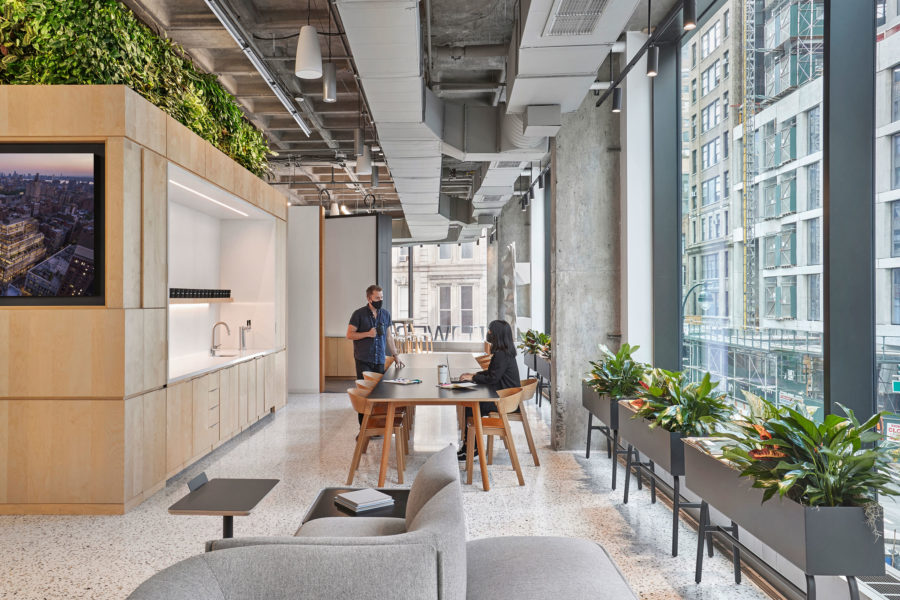
Pictured in the top left, the living wall inside Perkins&Will’s NYC office wraps around the center structure and is visible from nearly everywhere in the studio. Photo by Garrett Rowland
Living walls don’t have to be massive statement pieces to be inspiring. And that’s expertly showcased by the living wall in Perkins&Will’s New York studio.
Wrapping around the office’s central structure, the living wall is visible from almost anywhere, firmly anchoring the space in nature. “Not only do we want green in the space, we want people to see green at any point in the day no matter where they’re working,” Brent Capron, former principal and interior design director at Perkins&Will New York, previously told gb&d. “This wasn’t just a visual. We wanted something growing in our space. It visually makes people happier, and it is a natural air refresher.”
7. 20 Brattle Street, Cambridge, MA

20 Brattle Street’s moss-filled living wall panels and potted plants compliment reclaimed-wood accents from Oregon–based TerraMai. Photo by Chris Rogers
Designed by Dyer Brown & Associates, the 20 Brattle Street project—which provides young professionals with a flexible, sustainable office environment in the heart of Harvard Square—takes a similar, subtler approach to its living walls.
Rather than install a large, continuous expanse of vegetation along an entire wall, the office employs several smaller living wall panels featuring various species of moss. Set into a cubby-hole style partition wall, the panels are accompanied by potted plants, creating a diversity of textures, shapes, and forms; combined, the greenery helps to set off a multipurpose cafe/event space.

